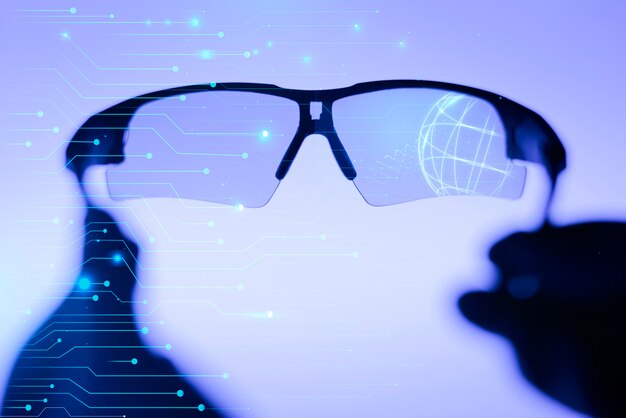
Our lives are knotted with screens in this digitally-driven world. Whether it’s for work, entertainment, or staying connected with loved ones, we spend hours each day staring at screens – smartphones, tablets, computers, and televisions. While these devices have undoubtedly revolutionized our lives, they also pose significant challenges to our eye health.
The constant exposure to screens has led to increased digital eye strain, also known as computer vision syndrome, and other vision-related problems. Here, we will explore the various ways in which you can protect your vision in a digital world with insights and advice from Dr. Aarti Pandya, an experienced ophthalmologist.

Understanding Digital Eye Strain
Digital eye strain is a common disorder that affects people who spend long hours in front of screens. Its symptoms include eye discomfort, dryness, redness, blurred vision, headaches, and neck and shoulder pain. Dr. Pandya emphasizes that understanding the root causes of digital eye strain is essential for effective prevention and management.
- Proper Screen Ergonomics: Dr. Pandya advises that one of the main reasons for digital eye strain is poor screen ergonomics. Many people position their screens too high or too low, leading to uncomfortable viewing angles. To protect your vision, ensure your screen is at eye level, and your chair and keyboard are adjusted for a comfortable posture.
- The 20-20-20 Rule: Dr. Pandya recommends following the 20-20-20 rule. For each 20 minutes of screen time, take a 20-second break and look at approximately 20 feet away. This easy exercise can help reduce eye strain significantly by giving your eye muscles a chance to relax.
- Blink Regularly: Staring at screens often reduces blink rates, resulting in dry eyes. Dr. Pandya stresses the importance of blinking regularly while using a smartphone or working on a computer. This helps keep the eyes moist and prevents dryness.
- Blue Light Filters: Many digital devices emit blue light, contributing to eye strain and disrupting sleep patterns if used before bedtime. Dr. Pandya recommends using blue light filters or wearing blue light-blocking glasses to reduce the harmful effects of blue light on your eyes.
- Adjust Screen Brightness: Another crucial tip from Dr. Pandya is to adjust your screen’s brightness to match the ambient lighting conditions. Screens that are too bright or too dim can strain your eyes. Opt for a screen brightness that feels comfortable and reduces glare.
Nutrition for Healthy Eyes
In addition to adopting good screen habits, your diet is very important in maintaining healthy eyes. Dr. Pandya emphasizes that a balanced diet rich in specific nutrients can help protect your vision.
- Vitamins A and C: These vitamins are essential for maintaining the health of your eyes. Foods like carrots, sweet potatoes, citrus fruits, and strawberries are excellent sources of vitamins A and C. Including them in your diet can promote good eye health.
- Omega-3 Fatty Acids: Dr. Pandya recommends incorporating omega-3 fatty acids, found in fish such as salmon, mackerel, and trout, into your meals. These fatty acids help prevent dry eyes and reduce the possibility of age-related macular degeneration (AMD).
- Lutein and Zeaxanthin: Leafy greens such as kale and spinach comprise lutein and zeaxanthin, which are antioxidants that protect the eyes from harmful light and oxidative damage. Dr. Pandya suggests adding these greens to your diet regularly.
- Stay Hydrated: Accurate hydration is essential for maintaining eye moisture. Drinking plenty of water can help you to avoid dry eyes and keep your vision comfortable.
Eye Exams and Regular Check-ups
Regular eye check-ups are vital for maintaining good eye health, especially in a digital world. Dr. Pandya recommends scheduling eye exams at least once a year, even if you don’t have any apparent vision problems. These exams can detect early signs of eye conditions such as glaucoma, cataracts, and AMD, which can be effectively managed if detected in their early stages.
Additionally, if you already wear contact lenses or glasses, keeping your prescription up to date is essential. The digital world demands clear and comfortable vision, and an outdated prescription can lead to increased eye strain.
Proper Lighting and Workspace
The lighting in your workspace and environment is important in protecting your vision. Dr. Pandya offers some tips on optimizing your surroundings:
- Natural Lighting: Position your workspace near natural light sources like windows whenever possible. Natural light is easier on the eyes than artificial lighting.
- Reduce Glare: Minimize glare on your screens by adjusting your screen angle or using an anti-glare filter. A harsh glare can cause discomfort and eye strain.
- Proper Room Lighting: Ensure that the lighting in your room is evenly distributed. Overly bright or dim lighting can strain your eyes as they work to adjust to the changing conditions.
- Use Task Lighting: If you’re reading or writing, consider using task lighting to illuminate your work area specifically. This reduces the strain on your eyes and allows you to focus better.
Digital Detox and Restful Sleep
Taking breaks from digital devices is crucial for your overall well-being, including your eye health. Dr. Pandya recommends the following practices:
- Digital Detox: Designate periods during the day when you disconnect from your screens completely. Engage in activities that don’t involve screens, such as reading a physical book, going for a walk, or practicing a hobby.
- Adequate Sleep: Ensuring you get enough sleep is essential for eye health. Quality sleep allows your eyes to rest and regenerate. Dr. Pandya advises establishing a regular sleep schedule and avoiding screens for a minimum of an hour before bedtime to improve sleep quality.
- Stay Hydrated: Proper hydration is essential for preventing dry eyes, which can be exacerbated by prolonged screen time. Drink water regularly to maintain eye moisture.
Conclusion
In our increasingly digital world, protecting your vision is of utmost importance. By following Dr. Aarti Pandya’s recommendations, you can significantly reduce the risk of digital eye strain and maintain healthy eyes in the long run. Remember that your eye health is a valuable asset, and it’s worth investing time and effort to protect it in our modern, screen-centric lives. So, take a proactive approach to safeguard your vision and enjoy a clear, comfortable view of the digital world.

